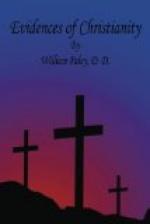Mr. Gibbon has argued for the genuineness of the Koran, from the confessions which it contains, to the apparent disadvantage of the Mahometan cause. (Vol. ix. c. 50, note 96.) The same defence vindicates the genuineness of our Gospels, and without prejudice to the cause at all.
There are some other instances in which the evangelists honestly relate what they must have perceived would make against them.
Of this kind is John the Baptist’s message preserved by Saint Matthew (xi. 2) and Saint Luke (vii. 18): “Now when John had heard in the prison the works of Christ, he sent two of his disciples, and said unto him, Art thou he that should come, or look we for another?” To confess, still more to state, that John the Baptist had his doubts concerning the character of Jesus, could not but afford a handle to cavil and objection. But truth, like honesty, neglects appearances. The same observation, perhaps, holds concerning the apostacy of Judas.*
_________
* I had once placed amongst these examples of fair concession the remarkable words of Saint Matthew in his account of Christ’s appearance upon the Galilean mountain: “And when they saw him they worshipped him; but some doubted.” (Chap. xxviii. 17.) I have since, however, been convinced, by what is observed concerning this passage in Dr. Townshend’s Discourse (Page 177.) upon the Resurrection, that the transaction, as related by Saint Matthew, was really this: “Christ appeared first at a distance; the greater part of the company, the moment they saw him, worshipped, but some as yet, i.e. upon this first distant view of his person, doubted; whereupon Christ came up to them, and spake to them,"+ &c.: that the doubt, therefore, was a doubt only at first for a moment, and upon his being seen at a distance, and was afterwards dispelled by his nearer approach, and by his entering into conversation with them.
+ Saint Matthew’s words are: kai proselthon o Iesous elalesen autois [and having come toward them, Jesus spoke]. This intimates that when he first appeared it was at a distance, at least from many of the spectators. Ib. p. 197. _________
John vi. 66. “From that time, many of his disciples went back, and walked no more with him.” Was it the part of a writer who dealt in suppression and disguise to put down this anecdote? Or this, which Matthew has preserved (xii. 58)? “He did not many mighty works there, because of their unbelief.”
Again, in the same evangelist (v. 17, 18): “Think not that I am come to destroy the law or the prophets: I am not come to destroy, but to fulfil; for, verily, I say unto you, till heaven and earth pass, one jot, or one tittle, shall in no wise pass from the law, till all be fulfilled.” At the time the Gospels were written, the apparent tendency of Christ’s mission was to diminish the authority of the Mosaic code, and it was so considered by the Jews themselves. It is very improbable, therefore, that, without the constraint of truth, Matthew should have ascribed a saying to Christ, which, primo intuitu, militated with the judgment of the age in which his Gospel was written. Marcion thought this text so objectionable, that he altered the words, so as to invert the sense. (Lardner, Cred., vol. xv. p. 422.)




